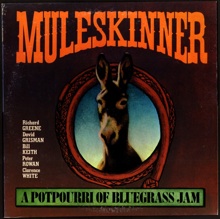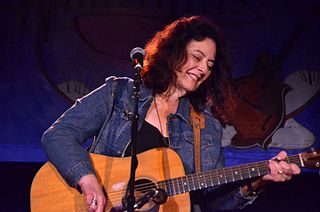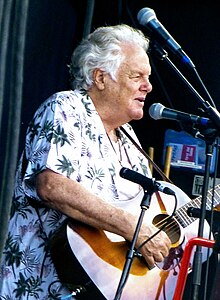
David Jay Grisman is an American mandolinist. His music combines bluegrass, folk, and jazz in a genre he calls "Dawg music". He founded the record label Acoustic Disc, which issues his recordings and those of other acoustic musicians. He was inducted into the International Bluegrass Music Hall of Fame in 2023.

David Anthony Rice was an American bluegrass guitarist. He was an influential acoustic guitar player in bluegrass, progressive bluegrass, newgrass and acoustic jazz. He was inducted into the International Bluegrass Music Hall of Fame in 2013.

Muleskinner was an American bluegrass supergroup, active during the early 1970s.

James Dee Crowe was an American banjo player and bluegrass band leader. He first became known during his four-year stint with Jimmy Martin in the 1950s. Crowe led the bluegrass group New South from 1971 until his death in 2021.

Delano Floyd McCoury is an American bluegrass musician. As leader of the Del McCoury Band, he plays guitar and sings lead vocals along with his two sons, Ronnie McCoury and Rob McCoury, who play mandolin and banjo respectively. In June 2010, he received a National Heritage Fellowship lifetime achievement award from the National Endowment for the Arts and in 2011 he was elected into the International Bluegrass Music Hall of Fame.

James Bryan Sutton is an American musician. Primarily known as a flatpicking acoustic guitar player, Sutton also plays mandolin, banjo, ukulele, and electric guitar. He also sings and writes songs.

Doyle Wayne Lawson is an American traditional bluegrass and Southern gospel musician. He is best known as a mandolin player, vocalist, producer, and leader of the 6-man group Doyle Lawson & Quicksilver. Lawson was inducted into the International Bluegrass Music Hall of Fame in 2012.

That High Lonesome Sound is the second live release of bluegrass music by Old & In the Way. Like the first one, Old & In the Way, it was recorded at the Boarding House in San Francisco in October 1973. It was released in February 1996.
James E. “Jim” Nunally is an American musician thet plays bluegrass-style, flat pick guitar with John Reischman and the Jaybirds, and with The David Grisman Bluegrass Experience. Jim has received two Grammy award certifications and two IBMA awards for his performance on the 1996 Bluegrass Album of the Year True Life Blues: The Songs of Bill Monroe.

Medicine Trail is a solo album by country rock and bluegrass musician Peter Rowan. The guest musicians include Jerry Douglas, Ricky Skaggs, David Grisman, Mike Auldridge, Flaco Jimenez, and Peter's brother Lorin Rowan. Many songs are about the oppression of American Indians. Greg Irons provided some of the artwork.

Old & In the Gray is a bluegrass album released in 2002 by the surviving members of the band Old & In the Way – Peter Rowan (guitar), David Grisman (mandolin), and Vassar Clements (fiddle). Banjoist Jerry Garcia and bassist John Kahn, both of whom were deceased, were replaced by Herb Pedersen and Bryn Bright, respectively.
Richard Greene is an American violinist who has been described as "one of the most innovative and influential fiddle players of all time". Greene is credited with introducing the chop to fiddle playing while working with Bill Monroe and the Blue Grass Boys, the invention of which he attributes to pain in his wrist and arm and "laziness". He featured the technique in his performances with Seatrain.

William Bradford "Bill" Keith was a five-string banjoist who made a significant contribution to the stylistic development of the instrument. In the 1960s he introduced a variation on the popular "Scruggs style" of banjo playing which would soon become known as melodic style, or "Keith style". He was inducted into the International Bluegrass Music Hall of Fame in 2015.
Michael Compton is an American bluegrass mandolin player and former protégé of the Father of Bluegrass, Bill Monroe. He is considered a modern master of bluegrass mandolin.

DGQ-20 is a 1996 compilation album by American musician David Grisman, recorded with his group David Grisman Quintet. Spanning the period from 1976 to 1996, this triple-CD set offers 39 songs, 18 of which were not released by Grisman before. Musicians include Tony Rice, Béla Fleck, Sam Bush, Mark O'Connor, Stephane Grappelli and others.

Muleskinner is the eponymous debut album by the progressive bluegrass group Muleskinner, recorded at the Record Plant, Hollywood, California, March 27 through April 14, 1973, and released later that year. It is their only studio album. The album was re-released by Ridge Runner in 1978 and re-issued on a compact disc in 1994 under the title A Potpourri of Bluegrass Jam, which was a banner on the front cover of the original album release.

Walker's Run is an acoustic bluegrass band based out of Lexington, Virginia who also play New Grass and Jazz music.

Live at the Boarding House: The Complete Shows is a four-CD live album by the bluegrass band Old & In the Way. It was recorded on October 1 and October 8, 1973, at the Boarding House in San Francisco, and contains the complete concerts from those dates. It was released by Acoustic Disc and Acoustic Oasis on October 1, 2013. The album includes 55 tracks, 14 of which were previously unreleased.

Kathy Kallick is an American bluegrass musician, bandleader, vocalist, guitar player, songwriter, and recording artist.

The mandolin has had a place in North American culture since the 1880s, when a "mandolin craze" began. The continent was a land of immigrants, including Italian immigrants, some of whom brought their mandolins with them. In spite of the mandolin having arrived in America, it was not in the cultural consciousness until after 1880 when the Spanish Students arrived on their international performing tour. Afterwards, a "mandolin craze" swept the United States, with large numbers of young people taking up the instrument and teachers such as Samuel Siegel touring the United States. The fad died out after World War I, but enough had learned the instrument that it remained. The mandolin found a new surge with the music of Bill Monroe; the Gibson F-5 mandolin he played, as well as other archtop instruments, became the American standard for mandolins. Bowlback mandolins were displaced. The instrument has been taken up in blues, bluegrass, jug-band music, country, rock, punk and other genres of music. While not as popular as the guitar, it is widespread across the country.




















